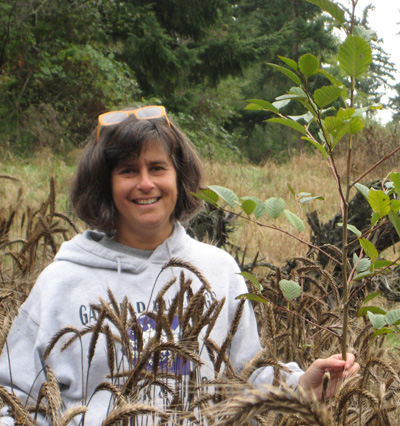
Biosolids for reclamation of disturbed land:
Vashon Island, WA, Bunker Hill, ID, Leadville, CO, Coeur d'Alene, ID

Dr. Sally Brown
Research Associate Professor:
School of Forest Resources
University of Washington
203 Bloedel Hall
Box 352100
Seattle, Washington 98195-2100
Telephone: (206) 616-1299
Fax: (206) 685-3091
Email:
slb@u.washington.edu
Research Interests:
My research has centered around cleaning things up, generally contaminated soils. My first efforts were with metal hyperaccumulator plants and more recently with different soil amendments.
Soil amendments, in the form of residuals from different industries (municipal biosolids, composts, high calcium carbonate wastes...) offer the potential to do more than fix contaminated sites. Increased and targeted uses of these materials offer the potential for us to live in a more sustainable manner.
Lately, I've been focusing on innovative uses for these materials in the hopes that identifying different uses and benefits for residuals will result in greater public acceptance.
Research Projects, Past and Present:
My research partners and I have worked on studies involving soil health, climate change mitigation, biosolids recycling and wastewater treatment:

Selected Publications:
Brown, S., D. Devin-Clarke, M. Doubrava, G. O'Connor. 2009. Fate of 4-nonylphenol in a biosolids amended soil. Chemosphere, 75(4): 549-554.
Brown, S., C. Kruger, S. Subler. 2008. Greenhouse Gas Balance for Composting Operations. J. Environ. Qual. 37: 1396–1410.
Brown, S. 2008. Climate Change Connections. BioCycle, 49(5): 22-23.
Svendson, A., C. Henry and S. Brown. 2007. Revegetation of High Zinc and Lead Tailings with Municipal Biosolids and Lime: Greenhouse Study. J. Environ. Qual. 36: 1609–1617.
Brown, S. 2007. Climate Change Connections. BioCycle, 48(11): 21.
Brown, S. 2007. Climate Change Connections. BioCycle, 48(10): 18.
Brown, S.L., H. Compton, N.T. Basta. 2007. Field Test of In Situ Soil Amendments at the Tar Creek National Priorities List Superfund Site. J. Environ. Qual. 36: 1627–1634.
Allen, H.L. IV, S. Brown, R. Chaney, W.L. Daniels, C.L. Henry, D.R. Neuman, Dr. E. Rubin, J. Ryan, and W. Toffey. 2007. The Use of Soil Amendments for Remediation, Revitalization, and Reuse. Environmental Protection Agency, Document #542-R-07-013.
Brown, S. 2007. Climate Change Connections. BioCycle, 48(7): 21.
Brown, S., B. Christensen, E. Lombi, M. McLaughlin, S. McGrath, J. Colpaert, and J. Vangronsveld. 2005.
An Inter-laboratory study to test the ability of amendments to reduce the availability of Cd, Pb, and Zn in-situ. Environmental Pollution, 138: 34-45.
Brown, S., M. Sprenger, A. Maxemchuk and H. Compton. 2005.
Ecosystem Function in Alluvial Tailings after Biosolids and Lime Addition. J. Environ. Qual. 34:139-148.
Brown, S.L., R.L. Chaney, J. Halfrisch, J. Ryan and W.R. Berti. 2004.
In Situ Soil Treatments to Reduce the Phyto- and Bioavailability of Lead, Zinc, and Cadmium. J. Environ. Qual. 33: 522-531.
Brown, S. and P. Leonard. 2004. Biosolids and global warming: Evaluating the management impacts. Biocycle, August.
Brown, S. and P. Leonard. 2004. Building carbon credits with biosolids recycling: Part II. Biocycle, September: 25-29.
Ryan, J.A., W.R. Berti, S.L. Brown, S.W. Casteel, R.L. Chaney, M. Doolan, P. Grevatt, J. Hallfrisch, M. Maddaloni, D. Moseby, and K. Scheckel. 2004. Reducing children's risk to soil lead: summary of a field experiment. Environ. Sci. and Tech. 38: 19a-24a.
DeVolder, P., S.L. Brown, D. Hesterberg and K. Pandya. 2003. Metal bioavailability and speciation in a wetland tailings repository amended with biosolids compost, wood ash, and sulfate. J. Environ. Qual., 32 (3): 851-864.
Brown, S. , R. Chaney, J. Halfrisch, and Q., Xue. 2003.
Effect of Biosolids Processing on Lead Bioavailability in an Urban Soil. J. Environ. Qual. 32: 100-108.
Brown, S., C.L. Henry, R.Chaney, H. Compton, and P.S. DeVolder. 2003. Using municipal biosolids in combination with other residuals to restore metal-contaminated mining areas. Plant and Soil, 249: 203-215.
Brown, S.L., R. Chaney, M. Sprenger, and H. Compton. 2002. Assessing impact to wildlife at biosolids remediated sites. BioCycle, August: 50-58.
Brown, S.L., R. Chaney, M. Sprenger, and H. Compton. 2002. Soil remediation using biosolids. BioCycle, June: 41-44.